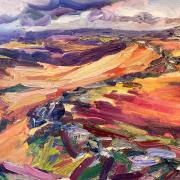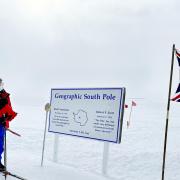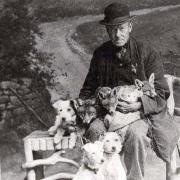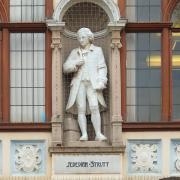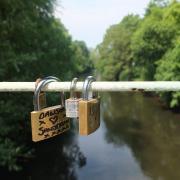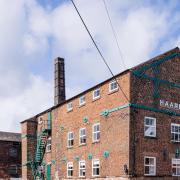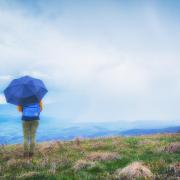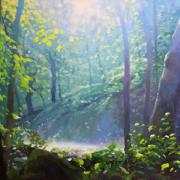Mike Smith meets Dronfield climber Adele Pennington who fulfilled her
34-year-old dream to conquer Everest
In 1974, six-year-old Adele Pennington climbed Snowdon with her step-father. The pair became hopelessly lost in a dense mist and had great difficulty finding their way down the mountain. When they finally arrived at the family’s holiday caravan, long after their scheduled return, Adele’s step-father was strongly reprimanded by his wife for placing their daughter in such a dangerous situation. However, a warning to ‘never do that again’ was not what Adele wanted to hear. As far as she was concerned, she’d had the most exciting day of her life. She told her mother, ‘One day, I’m going to climb Everest.’
That ambition to climb the world’s highest mountain stayed with Adele, even when she discovered that Everest is over eight times higher than Snowdon and that the cost of an ascent can be as much as $60,000. Knowing that she would need to get some qualifications, find a job and earn money before fulfilling her dream, she made the most of her academic potential, obtaining a degree in Biochemistry at London University, followed by a PhD at York University and a Graduate Certificate in Outdoor Education and Chemistry at Bangor University.
Before embarking on a career as a teacher of Chemistry, Adele had already begun her parallel career as a mountaineer, not only by undertaking climbs in the Alps, but also by joining the Scarborough and District Search and Rescue Team. Her most harrowing experience with the team came in 1988, when members of the group were asked to join in the search for bodies after a bomb exploded on Pan Am flight 103 as it passed over Lockerbie.
In 1998, Adele was invited to join a party of climbers on an expedition to Ama Dablam, a 22,349 ft peak in eastern Nepal. She became the first British woman to make a winter ascent of the mountain, which has a famous overhanging glacier and culminates in a gigantic pinnacle at the summit. This towering achievement was followed by a life-threatening failure just one year later, when Adele made a ‘technical error’ while climbing in the Alps near Chamonix.
After coming off her climbing rope, she fell into a gully and spent 17 hours lying in the snow before being airlifted to safety. Her horrendous injuries included a broken jaw, a crushed skull, a fractured pelvis and a broken back. When doctors told her that she might not be able to walk again, the dream of climbing Everest looked as if it could turn into the nightmare of spending the rest of her life in a wheelchair.
Adele did indeed spend several months in a wheelchair, but sheer determination enabled her to walk again with the aid of crutches and then to begin limping along without any aids at all. While most people in her situation would have stopped dreaming about scaling challenging peaks and concentrated their efforts on coping with mobility problems in everyday life, Adele was determined to get back to the mountains, just as she had been after her ordeal on Snowdon at the age of six.
Explaining her response, she said: ‘I had always lived and breathed climbing and I knew that I couldn’t be properly fulfilled without it. The accident spurred me on and made me return with a vengeance.’ In fact, Adele was so determined to resume her climbing career that she gave up her teaching post shortly after she had regained enough strength to go back into the classroom, in order to take up a job with Jagged Globe, a Sheffield company that organizes commercial climbing expeditions and provides mountain guides. She looked forward to leading groups to some of the world’s highest summits and, of course, she hoped that one of those would be Everest.
In 2007, Adele went on an expedition to Shishapanga to make her first attempt on a mountain higher than 8,000 metres. The party was beaten back by severe weather conditions, but Adele decided that she would leave the group and go off to Cho-Oyu, a neighbouring 8,000 metres-plus peak, and climb it on her own. And so it was that she succeeded in scaling the world’s sixth highest mountain with ‘Ted’, her faithful teddy bear, as her only companion.
Thanks in part to a daily cycle commute from her home in Dronfield to her office in Sheffield, Adele is very fit and has lots of stamina. She also has the advantage, as she sees it, of a small, strong frame. Mingma, a Sherpa who has accompanied her on many climbs and has scaled Everest a staggering 14 times, has taken to calling her ‘Diddy’, but he is well aware that she has the ability to tackle peaks that are far from diddy. In 2008, Adele finally got the chance to take on the highest peak of all, when she was assigned by Jagged Globe to act as an Everest guide for anaesthetist Janet Pickett. The pair had an agonizingly long wait for a climbing permit because the Chinese authorities were imposing entry restrictions during the Olympic year. In the end, they got the go-ahead to make the climb that had been the stuff of Adele’s dreams for 34 years.
Adele gave an account of their ascent as part of an inspirational talk to a packed audience at Sheffield’s Lescar Hotel late last year and she added some further details when I met her at the Jagged Globe offices. I learned of the ever-present danger of avalanches, which causes climbers to set out in the early morning before the snow becomes softened by the sun. I could barely bring myself to watch as I saw pictures of Adele and Janet climbing gingerly along B&Q ladders as they crossed ravines and scaled vertical rock faces; I shivered when I heard that they had come across a dead body during their ascent and I celebrated Adele’s achievement when she unveiled photographs taken from the roof of the world at the moment she became the twentieth British woman to reach the top of Everest on 23rd May 2008.
A few months after climbing Everest, Adele went back to Nepal to climb Manaslu, her third 8,000 metres-plus summit within a year. At one stage during the successful ascent, her party spent ten hours climbing through an ice storm only to be beaten back by the weather. On the following day, they set out again and spent twelve hours climbing exactly the same terrain. It’s exactly this sort of determination that allowed Adele to return to the world’s highest peaks after her terrible accident in 1999 and made her resolve to climb Everest one day in response to being lost on Snowdon as a six-year-old.
Adele Pennington is based at Jagged Globe (0845 545 8848; www.jagged-globe.co.uk), which organizes expeditions to the world’s highest mountain ranges. She is available to give illustrated talks about her mountaineering experiences.





